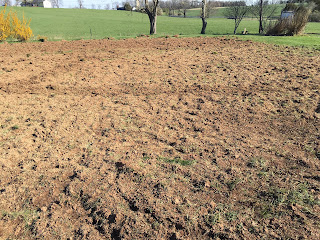I love cloudy days. I can walk outside with no glaring sun, I love the cool breeze and the rolling fields in the neighborhood are a bliss to watch. From grass to trees, groudhogs to cayotes, everything is waking up from hibernation. April has been cold so far. A couple of days of warm weather followed by cool days and cold nights. In those few warm days, I managed to set some cool season vegetables outside. Everyone who gardens knows what a delight it is to watch your plants grow and trees bloom in spring, especially when effort has been put in setting them up in your garden.
I prepared plant beds early this month to set a few early season vegetables in the ground. I put compost in the beds, weeded them and also covered them with cardboard sheet mulch. So far, cabbage, lettuce, onions, garlic, cilantro, watercress and spinach have found their happy place in the lap of mother earth. Hopefully, they will do well.
A bit on sheet mulching. For my garden, I did it the simple way this year. I bought old cardboard in bulk from someone who was selling it for free on craigslist (drove 50 miles to get the cardboard). I removed any staples, pins and tape from the cardboard, opened them and laid them on my beds for the entire length of the beds. On top of the cardboard, I put a layer of leaf compost and some heavy sod to hold the cardboard in place. I didn't had too many stones on the property so sod was the only thing that I could use to press the cardboard.
I found that young the young seedlings did surprisingly well in the ground in harsh weather days of April. At one eventful night when wind gusts of 40 mph blew my small hoophouse and a fix was done at 3:00 am, I woke up the next day to find all little transplants doing well in the ground. I couldn't exactly understand the reason but I was happy. There is something about being in contact with the earth that holds them together. The seedlings in trays or pots if subjected to strong winds and fluctuating temperature would have died. A few earlier sets of basil, watercress and cilantro indoors did die when accidentally left them hoophouse on a really cold night. Basil is a warm weather herb and I understand it can't tolerate cold after a few sets died. I need to make a mistake twice in order to learn a lesson from it.
I am sharing a few pictures of how my garden looks like at this time. On any given day, I prepare two beds and make them ready a week before transplanting my seedlings in ground. I punch holes in the cardboard and plant my transplants into them. There is obviously multiple ways of preparing beds, some more efficient than others. Cost though is a factor that I have to keep in mind during my first year. Let me know in comments below how do you take care of your early spring crops.
Happy Gardening.
 |
| Cilantro and watercress in one bed |
 |
Garlic shoot..just sprouting
|
 |
| Lettuce |
 |
| The little cabbage |
 |
| Spinach bed direct seeded. Lots of grass on the bed. |
 |
| Onions |
























